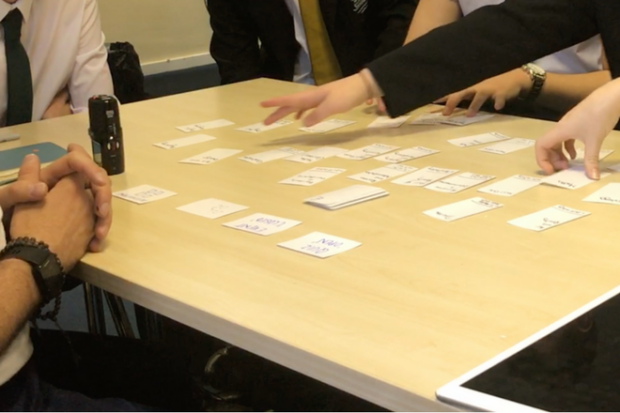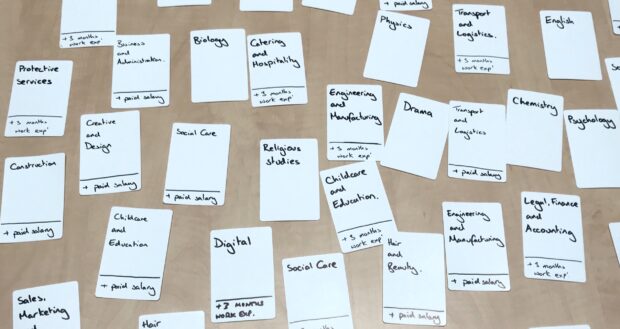
A discovery looking at post-16 choices was one of the the projects recommended by Department for Education’s service mapping earlier this year.
In future, students at 16 will need to choose between A levels, apprenticeships or T levels (a new technical study programme that will be available from September 2020).
These choices are complex and everyone has an experience - they remember their own choice or their kids (or grandkids) are making a choice soon. This is why user research is so important - it’s far too easy to put ourselves in the shoes of our users.
To simplify the complexity, we created a card game which became the basis for user research with students aged 14-18 years old. We learned that as well as being a great way to engage young people, the game also encouraged and facilitated group discussions between the students themselves.
Constraints are good
During planning, we discussed our research questions and ways we could run our user research sessions. We knew we were going to run group sessions with 14-18 years old. We knew it would be in schools and research labs. But we needed a way to control a complex set of variables.
We needed to:
- Manage the number of options so we could meaningfully investigate how choices are made
- Discuss the new T Level programmes in context without explaining them in detail
- Engage a range of participants 14-18 years old
- Find a way to give participants cues so that they placed themselves in the shoes of someone making a choice at 16. This ensured that they would engage with the session (we knew most sessions would be 20 minutes)
After a brainstorm, it became clear that a game mechanic would give us all the tools we needed. Games are competitive, interactive and physical - just like real life.
Designing the game
We created a card game. It was easy to make, cheap (all we needed were blank playing cards and a Sharpie) and we could iterate the game’s design across the research sessions.
The first day of research was a test. We had over 30 students between 12-16 years old. Treating this session as a test meant we could iterate the game - or dump it if it didn’t work. Luckily, it worked (and besides, plan B wasn’t as much fun).
To start the game, we laid out the cards on the table, face up. This included:
- Approximately 40 cards with different A level subjects
- 15 cards with different categories representing T level subjects. Those cards specified that 3 months of work experience was included in the qualification
- 15 cards based on the different categories of apprenticeships. Those cards specified that the students would also get a paid salary


Importantly, no card was labelled with its qualification title - this turned out to be very useful for exploring choices.
The rules were easy:
- Step 1 - make a hand: participants chose up to four cards - one for each of the options they would make at 16. We then discussed their choices. In groups, if someone selected a card that another participant wanted, we simply created a duplicate
- Step 2 - play events: in turn, each participant picked a card from the event deck. These included cards titled, ‘your family move away’, ‘you get 5 A* to C passes’ or ‘that course isn’t available in your area’. We then discussed their reactions to being in that situation and how that would impact their post-16 choices
- Step 3 - choose one: for anyone who had selected a T Level or apprenticeship card, we explained how this means they could only study that one thing, whereas for A Levels you can do up to four subjects. We also made them choose between their options and discuss how they felt about limiting themselves
- Step 4 - destination: participants chose their destination - where they want to go after having made their post-16 choices - from one of 4 choices: university, apprenticeship, job, or none of the above (probably being out of work)
Running the game
We ran the game with over 100 students in schools and research labs in London, Surrey, Middlesex and Manchester. Each session was run with 2-5 participants aged 14-18 years old. The game proved itself useful as a research tool to inform the team about some observable behavioural biases that would contribute to our recommendations. It offered a useful method to begin to quantify and compare choices. Several key things stood out:
- A game gives a great mechanism to cue a group into a shared activity quickly
- You only need limited explanation: play the game to understand the rules
- The game brings task-based activities into a ‘user group’ discussion
- It’s interactive so an easy way to facilitate discussion between participants (the game worked equally well with groups where participants knew each other as with groups where they didn’t)
- The process of going through the game is a useful exercise for students aged 16 who are thinking about their choices - it forces them to consider things they usually don’t think about
Scale it up
Our Choices card game proved a great research tool. As we move out of discovery phase into our alphas, we want to scale it up. If we think of the discovery game as a physical prototype, a next step could be to design an online version. Prototyping an online tool could enable the alpha teams to target larger cohorts of users across England in more diverse settings.
The real test will be to capture the richness of the responses we found during the interactive sessions. Now that will be a fun challenge.
If you want to get involved in the Post 16 Choices project or find out more about what we’re doing, we’d love to hear from you: fergus.roche@education.gov.uk
Recent Comments